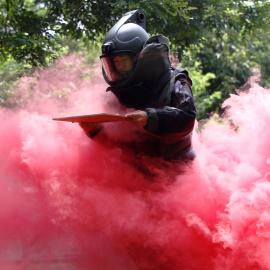I read with interest Caitlin Talmadge’s article “Beijing’s Nuclear Option” (November/December 2018), in which she quotes me estimating in 2015 that the odds of a U.S.-Chinese nuclear exchange were “somewhere between nil and zero.” She then goes on to make a case against remaining complacent in the face of the risk of escalation, with no discussion of what is in fact a very high nuclear threshold in a U.S.-Chinese confrontation or conflict. I continue to believe that the chances of nuclear use are very small.
Talmadge’s basic argument is that in any conflict with China, the United States will immediately launch a full-scale air and missile assault against military targets in mainland China and against Chinese attack submarines at sea. In so doing, she argues, the United States will inadvertently hit either China’s ballistic missile submarines or its mobile nuclear missiles. That, in turn, will present Chinese leaders with a “use it or lose it” dilemma concerning their nuclear arsenal, and they may well decide to launch a nuclear attack against the United States.
Such a scenario is extremely unlikely; indeed, I would say the odds are somewhere between nil and zero. A U.S.-Chinese conflict would be a maritime campaign in which the two sides tried to conquer or defend islands. Attacks on land targets beyond the contested islands and the waters around them, whether carried out by the United States against Chinese territory or by China against U.S. overseas bases, would be aimed at military installations and systems that supported the maritime campaign—ports, air bases, and command-and-control centers. The intercontinental nuclear deterrent forces of both countries are physically separate from these facilities.
In addition, U.S. planners are very mindful of the danger of attacking any state’s nuclear arsenal and take extraordinary precautions to avoid doing so. Although there is always a chance for an isolated mistake, it is in fact possible to distinguish nuclear-armed submarines from conventional ones. Likewise, it is possible to distinguish the shorter-range, dual-use missiles that threaten Taiwan, China’s neighbors, and U.S. bases in the Pacific from the intercontinental missiles that threaten the United States.
If by mistake a U.S. strike destroyed a land-based medium-range nuclear missile or sank a ballistic missile submarine, China would be greatly concerned, but it is highly unlikely that Beijing would respond by reflexively launching a nuclear attack against the United States. Rather, before even considering violating their long-held “no first use” doctrine, Chinese leaders would wait to see if a concerted, sustained U.S. campaign against their nuclear arsenal was under way. The United States has no incentive to attempt such a campaign and in fact would take every precaution to avoid it.
The real danger of escalation in these conflicts would be when a Chinese attempt to capture a disputed island—Taiwan, one of the Diaoyu/Senkaku Islands, or an island in the South China Sea—was failing. A failed attempt to regain territory that the Chinese government has claimed as its own would undermine the legitimacy of the Chinese Communist Party and could make Beijing desperate enough to threaten the use of nuclear weapons. Again, U.S. planners are aware of that danger and would seek to manage the end of a maritime conflict with China in a way that minimized the incentives for escalation.
Dennis C. Blair
Chair of the Board, Sasakawa Peace Foundation USA; U.S. Director of National Intelligence, 2009–10; Commander of U.S. Pacific Command, 1999–2002
TALMADGE REPLIES:
Dennis Blair’s letter reflects the conventional wisdom about a potential U.S.-Chinese war: virtual certainty that if the United States picked the right set of targets, China would understand that the war was limited, and nuclear weapons would be irrelevant. Everyone should hope that Blair is right, but amid the fog and suspicion of war, China’s views of both U.S. intentions and nuclear deterrence could change radically. Were a U.S. campaign to erode significant components of China’s deterrent capability, Chinese leaders could conclude—reluctantly—that limited escalation, such as a demonstration strike at sea, was a viable option.
Blair downplays growing linkages between China’s nuclear forces and its conventional forces. He states that in a maritime conflict, the United States would attack only Chinese ports, air bases, and command-and-control centers on the mainland, ignoring that some of these onshore assets support China’s nuclear-armed submarines, not just its conventional naval forces. With respect to a land-based conflict, I agree with Blair that the United States can distinguish China’s intermediate-range nuclear missiles from its intercontinental nuclear missiles. The question, however, is whether the United States can distinguish among different types of intermediate-range missiles, attacking only conventional ones while leaving the nuclear ones untouched. If it cannot do that—and as I explained in my article, it probably cannot—the question becomes whether China would worry about the security of its small force of nuclear-armed intercontinental ballistic missiles once the intermediate-range missiles and their air defenses were degraded.
Nevertheless, Blair overstates our differences in some places. I concur, for example, that “it is . . . possible to distinguish nuclear-armed submarines from conventional ones,” and I agree that “there is always a chance for an isolated mistake.” Where we depart, however, is on how China might react to such a mistake, one that would eliminate a quarter of the country’s naval nuclear deterrent.
My article explicitly notes that the likelihood of Chinese nuclear escalation is not high in absolute terms. The danger is of high consequence, not high probability. Yet the likelihood of a nuclear confrontation will grow if the United States confidently assumes, as Blair does, that China’s behavior will be both predictable and proportional.
